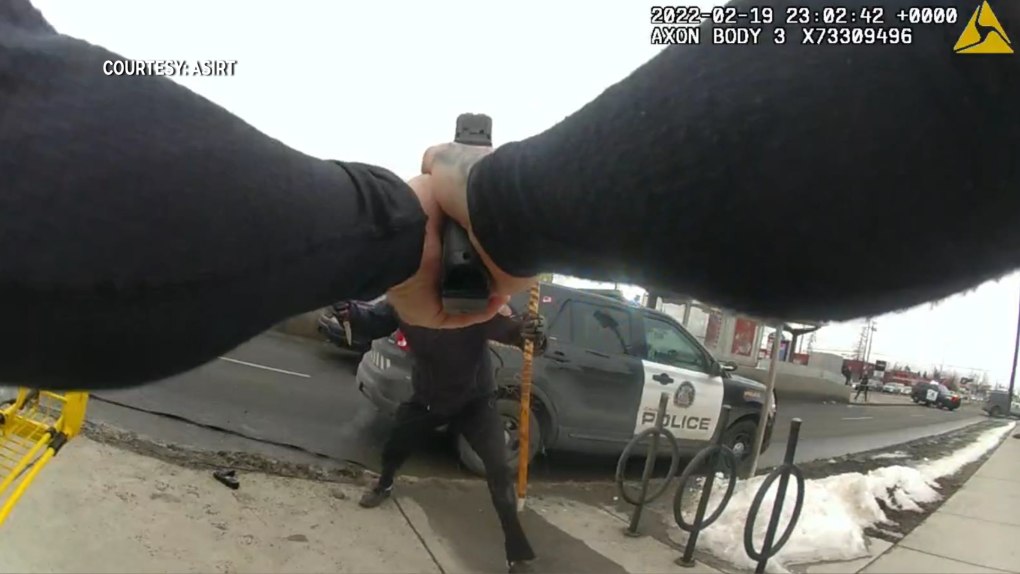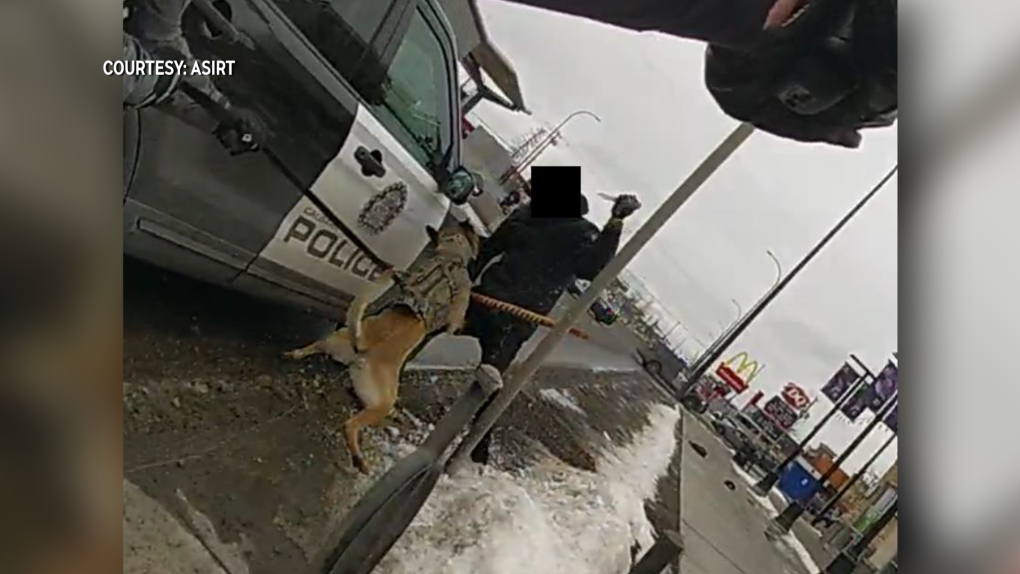World
Use of force in 2022 fatal police-involved shooting was ‘necessary’: ASIRT

A newly released report details the events that led up to the death of a man in a police-involved shooting in southeast Calgary in 2022, and rules that officers’ use of force was necessary.
Latjor Tuel was shot and killed following an altercation with police where he allegedly attacked a police service dog with a weapon.
The Alberta Serious Incident Response Team (ASIRT) released its decision on the officer-involved shooting on Friday, detailing the findings of its investigation and ruling that the officers’ use of force was “proportionate, necessary and reasonable.”
Tuel’s family says they are disappointed with the decision and have filed a lawsuit against the police service.
“There’s so much that I wish I could say to him before he passed, but I can’t because he’s gone,” said Tuel’s daughter Nyalinglat Latjor.
“Before my father was killed, he was going through a mental health crisis and he was suffering. I can’t tell you how amazing this man was.”
‘Put the knife down’
The ASIRT report details the events that led up to Tuel’s death.
The incident occurred on and along 17 Avenue between 44th Street and 45th Street southeast, on the afternoon of February 19, 2022.
A man, identified as the AP (affected person) in the report, was seen walking with a “strange gait while swinging a stick,” by video cameras in the area around 3:30 p.m.
Calgary police then received three 911 calls about a man matching the suspect’s description in the area. Two reported that an assault had occurred, with the man attacking another man with a stick. One of the callers also said he pulled out a knife and waved it at people.
Four officers arrived on the scene, between two police vehicles. The first witness officer spoke with one of the witnesses who had been chased by the man earlier. He then drew his conducted energy weapon and activated his body camera.
The first witness officer could be heard speaking to the suspect at the time, via the body camera footage, according to the report.
“It’s hard to talk to you when you are swinging a stick and a knife” and “What’s going on today? Just talk to us,” the first officer said.
The report states the man continued to speak in a “confusing manner, as he did for the entire encounter.”
The man spoke in full sentences and was responsive when officers spoke to him, but what he said did not appear to be connected to the situation, the report states.
Two of the officers continued to speak with the man, asking him to put the knife away.
Two more police vehicle arrived on the scene around 3:50 p.m. The man then sat down on the sidewalk.
The officers on scene continued to ask the man to drop his knife and deescalate the situation. Throughout the exchange, the man told the officers to shoot him.
“Shoot. Kill me. Shoot. Go ahead shoot,” the man said, according to the report.
“We’re obviously worried about you with the knife in your hand and you’re not putting it down, dude. Can you just put the knife down for us?” One of the officers responded.
A short time later, a friend of the man arrived on the scene and explained to the officers that the man had a problem with his roommate a few days earlier.
The officers continued to ask the man to drop his knife. His friend also spoke to him, in a non-English language.
A canine unit officer then also arrived on scene and brought his police dog out.
The officers discussed the situation, saying that there was no action needed as long as the man stayed sitting. If he got up, the officer identified as witness officer three would fire a less-lethal baton launcher at him.
Police asked his friend what the man was upset about, and he said he had been kicked out of his house and did not have a place to go, and had been walking around “the whole day and night.”
The man then stood up. As the police dog started to bark at the man, the officers told him to stay seated. He then went down to one knee.
As officers discussed the situation, the man then started to breathe heavily and shuffled toward them, the report states.
The man was asked to stop, and witness officer three fired his less-lethal baton launcher.
“The AP reacted by drawing in his right leg and then sitting down. He immediately stood back up into a crouch and hit the sidewalk with the end of the walking stick. He stood up fully and then crouched slightly,” the report reads.
Three officers then told him to drop the knife again. A second round from the less-lethal baton launcher was fired at the man, hitting him in the midsection.
The report said the man then lifted his walking stick in the air and struck the ground with it.
He then started to run in the direction of one of the officers near his police vehicle while holding the walking stick and knife. The officer backed up and the canine unit officer allowed his dog to have more leash, and the dog moved toward the AP.
(Source: ASIRT)
At this point, the man was within a few metres of the dog. As the man still had a knife, the officer pulled the dog back beside the police vehicle.
The man continued to move in the direction of the police dog and the officers, and one of the officers fired a taser at him. It appeared to attach to him.
“The AP reacted by bending over briefly. He then raised the walking stick and struck the (police dog) with it,” the report reads.
The dog then bit the man’s sleeve, and another taser was fired at him.
 (Source: ASIRT)
(Source: ASIRT)
The man brought the knife near the police dog, but it’s not clear if he made contact. He drew the knife up, and the officer pulled back on the dog’s leash.
The report states the man then stabbed the dog in the neck. One of the officers, identified as subject officer one, fired the first shot from his handgun.
 (Source: ASIRT)
(Source: ASIRT)
The police dog was pulled back further, still holding onto the man’s clothing. The man then stabbed at the dog three more times, which resulted in the dog releasing him.
A taser was deployed again, and the man fell to the ground behind the police vehicle.
The officers continued to ask the man to drop the knife, before he got up and moved toward another officer, while still holding the knife and walking stick.
After yelling at the man to “drop it, drop it,” the officer fired three shots from his handgun. The man fell to the sidewalk while still holding the knife.
Officers approached the man, with one kicking the knife out of his hand. He was handcuffed and EMS began first aid around 4:08 p.m.
The man was declared dead on scene at 4:26 p.m.
The report states the police dog was bleeding profusely on scene. He was given first aid and taken to an emergency veterinary clinic in life-threatening condition.
The dog, known as police service dog Jack, had one stab wound that went between two vertebrae, chipping one and severing an artery. He underwent surgery and received a blood transfusion.
Jack was released from care a few days later.
ASIRT investigation
ASIRT investigators processed the scene, seizing the knife and walking stick.
An autopsy was performed on Feb. 23, 2022, which determined the man had gunshot wounds on his left wrist, right chest, left back and left posterior neck. The pathologist concluded that the cause of death was due to “multiple firearm injuries to the body.”
There were no lacerations on the man’s right arm, where the dog had been holding on.
Toxicology showed no illegal drugs in the man’s system.
Investigators interviewed several witnesses, including the man’s friend. He said he was afraid the man would hurt himself or someone else.
The ASIRT investigation focused on the shots fired that caused the man’s death.
“While there were other uses of force by other officers, these actions are relevant only to how they affect the overall situation and are not under criminal investigation themselves,” the report states.
The ASIRT decision ruled that the police officers’ use of force was “proportionate, necessary, and reasonable,” and as a result, “there are no reasonable grounds to believe that an offence was committed.”
The report notes that the man presented a risk to officers, holding a knife and demonstrating “erratic, assaultive behaviour with pedestrians.”
“By first attempting de-escalation and then deploying multiple uses of force in a progression fashion, the officers in this incident acted reasonably,” the report reads.
‘Disappointed’
“I am disappointed in the decision by ASIRT, but I understand. I read through it countless times,” said Nyalinglat Latjor.
Latjor says her father was a child soldier who carried AK-47s around for war conflict in South Sudan. She adds that the police dog brought back painful memories for him, which she says escalated the situation, before her death.
“Dogs are used as a weapon, they’re used in war,” she said.
“When that dog started barking, it triggered him.”
The family’s lawyer and Criminal Trial Lawyers’ Association member Tom Engel says Calgary police failed Tuel that day and inappropriately used the canine officer.
“Why wasn’t that dog used to apprehend him? Sure, he would have suffered dog bites, but he would have been basically, eliminated as a threat to anyone and then taken into custody,” he said.
“Why didn’t they do that? They are trained to apprehend somebody with a weapon, including a knife. That wasn’t done.”
Engel says the family has filed a lawsuit against the police service and launched a fatality inquiry.
“My overriding concern with the tactics of the Calgary Police Service that day was how they used the dog,” said Engel.
“All that dog did was aggravate the situation.”
The Calgary Police Service provided a statement on Friday, following the release of the report.
“While we know the answers found in this report will not heal a family who have lost a loved one, or a community who were deeply impacted by the loss of one of their own, we appreciate the transparency the report provides and the objective conclusions of ASIRT,” the statement reads.
“Our officers made every attempt to de-escalate a situation that was already at an elevated risk with members of the public in harm’s way, several of whom had already been assaulted. Every non-lethal use of force option was used in an attempt to take the person into custody and as ASIRT has outlined, this was not a situation that would have been appropriate for intervention by civilian clinicians.”
CPS noted that regardless of the ASIRT findings, issues have been brought forward by the community that the service is committed to working together to address.


)






